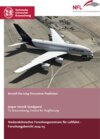Aircraft De-icing Occurence Prediction
von Jesper Henrik SandgaardFor a safe take-o_ operation during winter conditions aircraft have to be free of any ice residuals which can disturb the airflow around the structure. Therefore, de-icing before departure is required. Due to the difficult predictability of the icing conditions and the decision of the pilot in command, de-icing has a high potential to disrupt an airline’s network. Different procedures at airports need to be taken into account by airlines and pilots prior to departure. Missing the calculated take-off slot is the norm at an airport where de-icing operation is not common and it reduces the capacity of this airport.
In a qualitative interview approach the current situation showed, that de-icing is usually handled reactive. Beside basic weather prediction and in-flight icing warning, ground icing is not part of tactic decision making.
In this thesis, Machine Learning (ML) methods are used to predict the de-icing procedure at Munich Airport. There are two use cases which are viewed differently; One is the enhancement of weather prediction with weather reports and the other is the capture of de-icing events based on data. Similar to other industrial sectors, airlines restrict the access of collected data, but in contrast to other industries, aircraft are frequently sending their position. ADS-B signals collected and saved throughout years are used in this thesis as a foundation of combining aircraft positions with meteorological data. Apart from the mentioned positioning data, also surface data from Munich Airport, weather reports (METAR) and aerodrome forecasts (TAF) are used. A combined data set is generated which is complete for more than two years. Weather reports are available for more than ten years and are used by the developed algorithm to predict weather parameters based, on past weather reports and basic forecasts.
By using common hyper-parameter search methods two algorithms are selected, one for each use case. The weather prediction shows deviations of 2°C to 4°C within 75% of the forecasts. In comparison to other studies, it showed similar performance ranges, whereas compared to national weather providers the error range exceeded their performance. The de-icing prediction shows a reliance on the previously made weather prediction. The f-score of 78%indicates a satisfactory result, the performance decreased by using the earlier predicted temperatures instead of the „true“ temperatures. Also individual de-icing allocation to aircraft was done by correlation of the position and the de-icing pad. The quality of the de-icing assignments could not be verified with certainty (85% of the total cases were detected). For a de-icing prediction further studies should be done. A more reliable data source and the use of weather predictions from national weather providers could possibly increase the accuracy of these models.
In a qualitative interview approach the current situation showed, that de-icing is usually handled reactive. Beside basic weather prediction and in-flight icing warning, ground icing is not part of tactic decision making.
In this thesis, Machine Learning (ML) methods are used to predict the de-icing procedure at Munich Airport. There are two use cases which are viewed differently; One is the enhancement of weather prediction with weather reports and the other is the capture of de-icing events based on data. Similar to other industrial sectors, airlines restrict the access of collected data, but in contrast to other industries, aircraft are frequently sending their position. ADS-B signals collected and saved throughout years are used in this thesis as a foundation of combining aircraft positions with meteorological data. Apart from the mentioned positioning data, also surface data from Munich Airport, weather reports (METAR) and aerodrome forecasts (TAF) are used. A combined data set is generated which is complete for more than two years. Weather reports are available for more than ten years and are used by the developed algorithm to predict weather parameters based, on past weather reports and basic forecasts.
By using common hyper-parameter search methods two algorithms are selected, one for each use case. The weather prediction shows deviations of 2°C to 4°C within 75% of the forecasts. In comparison to other studies, it showed similar performance ranges, whereas compared to national weather providers the error range exceeded their performance. The de-icing prediction shows a reliance on the previously made weather prediction. The f-score of 78%indicates a satisfactory result, the performance decreased by using the earlier predicted temperatures instead of the „true“ temperatures. Also individual de-icing allocation to aircraft was done by correlation of the position and the de-icing pad. The quality of the de-icing assignments could not be verified with certainty (85% of the total cases were detected). For a de-icing prediction further studies should be done. A more reliable data source and the use of weather predictions from national weather providers could possibly increase the accuracy of these models.







